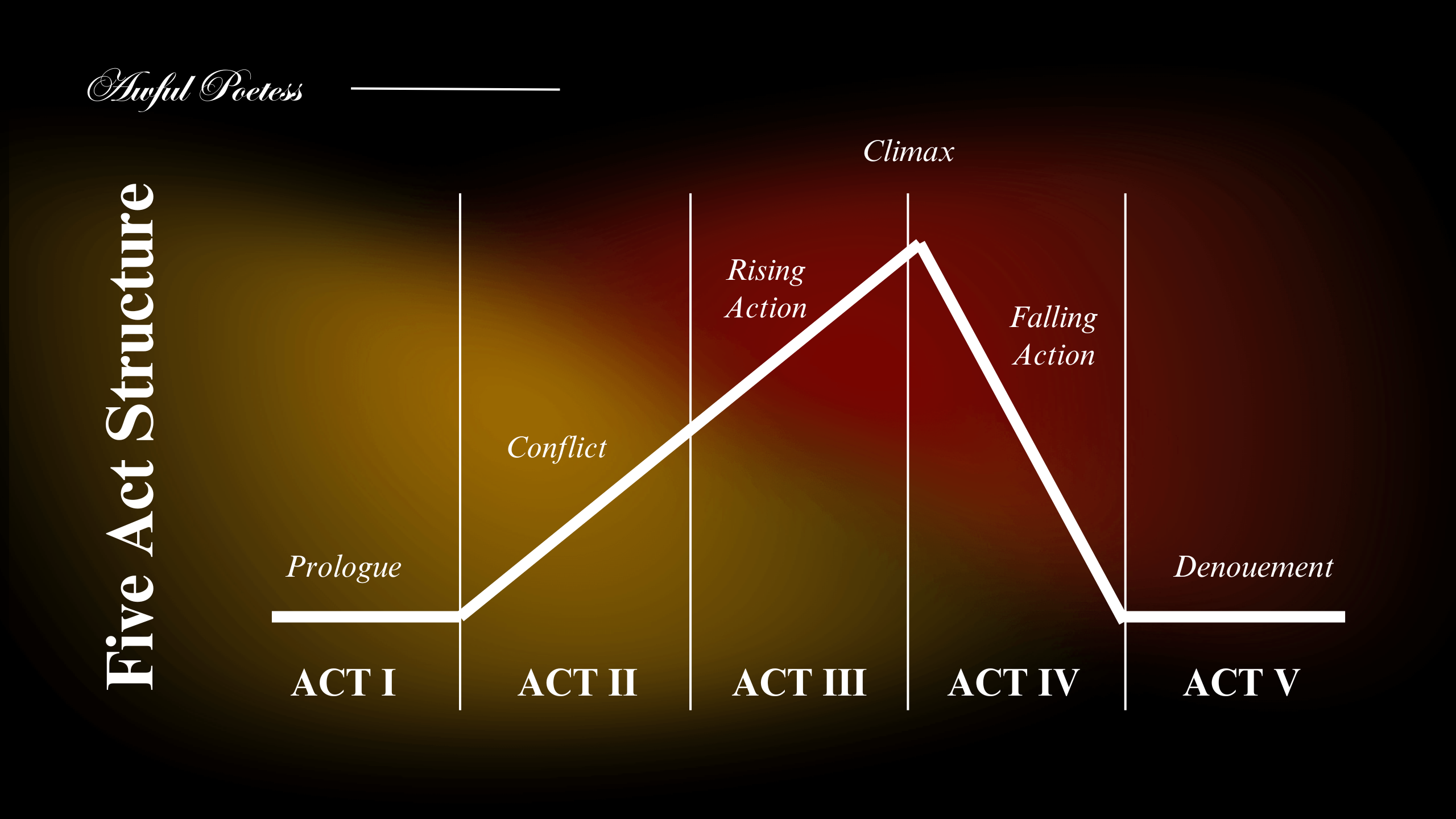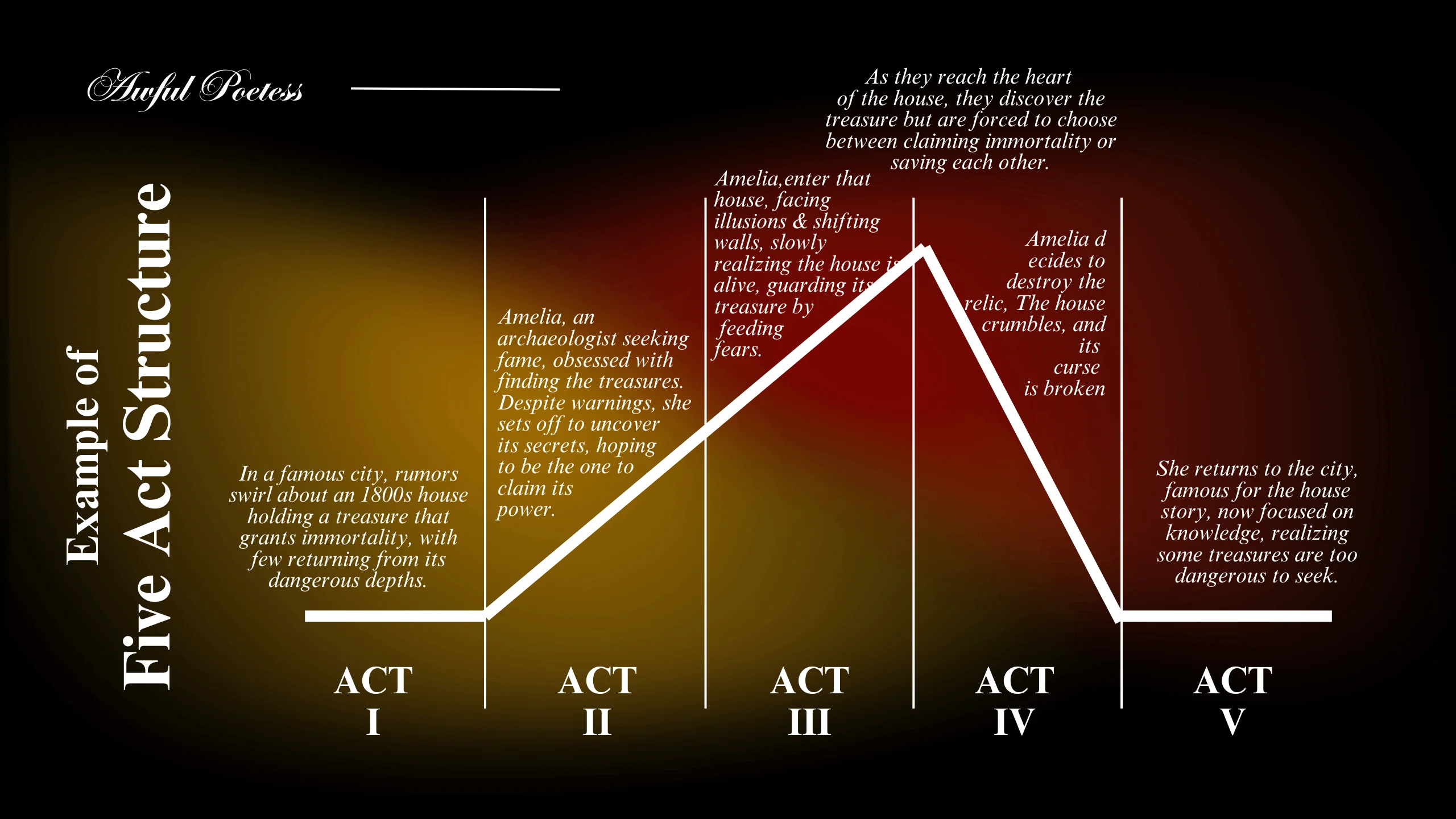If you find yourself asking, “How do I begin writing stories?” the most effective and succinct advice I can offer is this: learn story structures. After years of wasting and exploring various story writing lessons, I’ve concluded that mastering story structure (or you can call it plot structure and narrative story structure as well)—is fundamental for any writer.
In this blog, we are going to explore the second most famous story structure — The Five-Act Structure (The first one is the three-act story structure). From understanding what the five-act structure is to learn how to apply its concept to your own stories, we’ll cover everything from A to Z. By the end, you’ll find a practical story example along with a visual template (diagram) to help you grasp the structure more effectively. So, stay tuned!
What is The Five-Act Structure? | The Definition and Concept
The Five-Act Structure is a classic narrative framework that divides a story into five distinct sections, each serving a specific purpose in the story plot’s progression. Originating from ancient theatrical works, this structure breaks the story into Exposition (Story’s beginning), Rising Action, Climax, Falling Action, and Resolution (Story’s end)— guiding the journey of characters from introduction to conclusion.
The concept helps writers to write well-paced stories by ensuring each act builds tension, develops characters, and drives the plot forward, resulting in a cohesive and engaging narrative. Whether you’re writing novels, scripts, or short stories, the Five-Act Structure provides a solid foundation to organize your ideas effectively.
The History of The Five-Act Structure | Who Invented the Five-Act Structure
The Five-Act Structure dates back to ancient Greek and Roman theatre, where playwrights used this method to create their dramatic works. However, it was the Roman philosopher Horace who first hinted at dividing plays into five acts in his work Ars Poetica.
The structure gained widespread recognition through the works of Seneca, a Roman playwright. But it was later refined by the German playwright Gustav Freytag in the 19th century. And created another but similar story structure named “The Freytag’s Pyramid”. Freytag’s Pyramid became one of the most influential models, visualizing how stories naturally rise, peak, and resolve over five acts.
From Shakespearean dramas like Hamlet and Romeo and Juliet to modern screenplays and novels, the Five-Act Structure has stood the test of time — proving its ability to create balanced and compelling narratives.
The Confusion Between the Freytag’s Pyramid and Five-Act Structure
Many people assume that the five-act structure and Freytag’s pyramid are the same story structures but they are two different narrative structures. Even though they share some similarities.
The Five-Act Structure is an older story structure primarily used in plays and dramas (especially by Shakespeare). It’s more of a general story framework with distinct acts but without the specific visual pyramid shape.
Freytag’s Pyramid, on the other hand, is a visual model introduced by Gustav Freytag in 1863. It was designed to explain the structure of Greek and Shakespearean tragedies. Freytag’s Pyramid uses a triangular shape to represent:
Key points about the Freytag’s Pyramid:
- Visual Representation: Freytag’s pyramid is visualized as a triangle, with the rising action forming the ascending slope and the falling action forming the descending slope. Whereas the five-act structure is not typically represented visually in this way.
- Focus on Tension: Freytag’s pyramid places a strong emphasis on the building tension leading up to the climax, which is represented as the peak of the triangle.
The Story Structure of a Five-act structure
The Five-Act Structure breaks down a story into five key stages, each playing a vital role in the overall narrative. This structure helps writers maintain a smooth flow, build tension, and deliver a satisfying resolution.
1. Exposition
The story begins by setting the stage. This act introduces:
- Main characters
- The world or story settings
- Background information of main characters or theme
- Inciting Incident placement
- The central conflict or goal (Depends on whether you want to introduce in this part or further)
Purpose: To give readers the necessary context and spark curiosity for what’s to come.
2. Rising Action (Conflict Development)
The conflict starts to build as the protagonist faces obstacles and challenges. This act forms the bulk of the story where characters make decisions, alliances are formed, and stakes rise.
Purpose: To increase tension and keep readers invested by making the conflict more complex.
3. Climax (Turning Point)
This is the most intense and pivotal moment of the story — where everything reaches its breaking point. The protagonist makes a crucial decision that changes the course of the narrative. Here is a pinpoint of this step you can use multiple types of climaxes such as multiple climaxes, or mini climax of each story scene. But it’s better to first sketch your entire story with the original story structure and then go for changes you like to make)
Purpose of the main climax: To deliver the story’s highest emotional and dramatic peak.
4. Falling Action (Consequences)
After the climax, the story starts to wind down. Loose ends are tied up, but not without showing the aftermath of the protagonist’s choices.
Purpose: To gradually lower tension while preparing for the final resolution.
5. Resolution (Denouement)
The story concludes with either a happy, tragic, or ambiguous ending (depending on the story theme or plotting). Conflicts are resolved, and the characters’ arcs come to completion.
Purpose: To give readers closure and reflect on the overall journey.

Story Example Using the Five-Act Story Structure
Here’s the short concept of a story based on a five-act story structure:
- ACT I – Exposition (Introduction): In a famous city, rumours swirl about an 1800s house holding a treasure that grants immortality. With few returning from its dangerous depths.
- ACT II- Rising Action: Amelia, an archaeologist who wants to seek fame, is obsessed with finding hidden treasures and old places. Despite warnings by the neighbourhood and other people of the town, she sets off to uncover its secrets, hoping to be the one to claim its power.
- Rising Action 2: Amelia, enters that house, facing illusions & shifting walls, slowly realizing the house is alive, guarding its treasure by feeding fears.
- ACT III – Climax (Turning Point): As she reaches the heart of the house. They discover the treasure but are forced to choose between claiming immortality or saving each other
- ACT IV – Falling Action (Consequences): Amelia decides to destroy the relic as the house crumbles, and the house curse broken.
- Last ACT V – Resolution (Denouement): She returns to the city, famous for the house story, now focused on knowledge, realizing some treasures are too dangerous to seek.

Why Should You Choose This Framework?
Writers should choose the Five-Act Story Structure because it provides a clear and natural progression for building a well-paced narrative, especially for complex stories. This structure helps writers maintain a balance between character development, plot tension, and emotional payoff.
